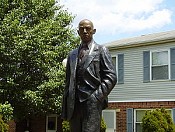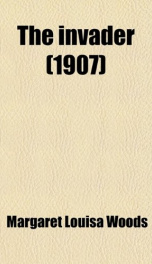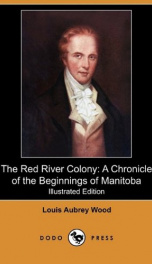Woodson Carter Godwin

Carter Godwin Woodson (December 19, 1875 - April 3, 1950)[1] was an African-American historian, author, journalist and the founder of the Association for the Study of African American Life and History. He was one of the first scholars to value and study Black History. He recognized and acted upon the importance of a people having an awareness and knowledge of their contributions to humanity and left behind an impressive legacy. A founder of Journal of Negro History, Dr. Woodson is known as the Father of Black History. [2] He was a member of the first black fraternity Sigma Pi Phi and a member of Omega Psi Phi.[3]. Dr.Carter G. Woodson was born in 1875 in New Canton, Virginia, the son of former slaves James and Elizae Riddle Woodson. His father helped Union soldiers during the Civil War, and he moved his family to West Virginia when he heard that Huntington was building a high school for blacks. Coming from a large, poor family, Carter Woodson could not regularly attend school. Through self-instruction, Woodson mastered the fundamentals of common school subjects by age 17. Wanting more education, Carter went to Fayette County to earn a living as a miner in the coal fields. He was able to devote only a few months each year to his schooling. In 1895, at age 20, Woodson entered Douglass High School where he received his diploma in less than two years. From 1897 to 1900, Woodson taught in Fayette County. In 1900 he was selected as the principal of Douglass High School. He earned his Bachelor of Literature degree from Berea College in Kentucky. From 1903 to 1907 Woodson was a school supervisor in the Philippines. Later, he attended the University of Chicago, where he was awarded an M.A. in 1908. He completed his Ph.D. in history at Harvard University in 1912. His doctoral dissertation,The Disruption of Virginia, was based on research he did at the Library of Congress while teaching high school in Washington, D.C. After earning the doctoral degree, he joined the faculty at Howard University as a professor. Convinced that the role of his own people in American history and in the history of other cultures was either being ignored or misrepresented among scholars, Woodson realized the need for research into the neglected past of African Americans. He and Jesse E. Moorland founded the Association for the Study of Negro Life and History September 9, 1915, in Chicago.[4] That was also the year Woodson published The Education of the Negro Prior to 1861. His other books followed: A Century of Negro Migration] (1918) and The History of the Negro Church (1927). His work The Negro in Our History has been reprinted in numerous editions and was revised by Charles H. Wesley after Woodson's death in 1950. In January 1916, Woodson began publication of the scholarly Journal of Negro History. It has never missed an issue, despite the Great Depression, loss of support from foundations and two World Wars. In 2002, it was renamed the Journal of African American History and continues to be published by the Association for the Study of African American Life and History (ASALH). Woodson became affiliated with the organized Washington, D.C. branch of the NAACP, and its Chairman Archibald Grimké. On January 28, 1915, he wrote a letter to Grimké expressing his dissatisfaction with the way things were going. Woodson made two proposals: W. E. B. Du Bois added the daring proposal of "diverting patronage from business establishments which do not treat races alike." He wrote that he would cooperate as one of the twenty-five effective canvassers, adding that he would pay the office rent for one month. The NAACP did not welcome Dr. Woodson's ideas. In a letter to Grimké on March 18, 1915, responding to comments about his proposals, Woodson wrote, This difference of opinion with Grimké contributed to Woodson's ending his affiliation with the NAACP. After leaving Howard University because of differences with its president, Dr. Woodson devoted the rest of his life to historical research. He worked to preserve the history of African Americans and accumulated a collection of thousands of artifacts and publications. He noted that African American contributions "were overlooked, ignored, and even suppressed by the writers of history textbooks and the teachers who use them." [5]. Race prejudice, he concluded, "is merely the logical result of tradition, the inevitable outcome of thorough instruction to the effect that the Negro has never contributed anything to the progress of mankind." [6] In 1926, Woodson single-handedly pioneered the celebration of "Negro History Week", for the second week in February, to coincide with marking the birthdays of Abraham Lincoln and Frederick Douglass.[7]. The week was later extended to the full month of February and renamed Black History Month. Woodson believed in self-reliance and racial respect, values he shared with Marcus Garvey. Woodson became a regular columnist for Garvey's weekly Negro World. Woodson's political activism placed him at the center of a circle of many black intellectuals and activists from the 1920s to the 1940s. He corresponded with W. E. B. Du Bois, John E. Bruce, Arturo Alfonso Schomburg, Hubert H. Harrison, and T. Thomas Fortune among others. Even with the extended duties of the Association, Woodson made time to write academic works such as The History of the Negro Church (1922), The Mis-Education of the Negro (1933), and others which continue to have wide readership. Woodson did not shy away from controversial subjects, and used the pages of Negro World to contribute to debates. One issue related to West Indian/African American relations. Woodson summarized that "the West Indian Negro is free." He observed that West Indian societies had been more successful at properly dedicating the necessary amounts of time and resources needed to educate and genuinely emancipate people. Woodson approved of efforts by West Indians to include materials related to Black history and culture into their school curricula. Woodson was ostracized by some of his contemporaries because of his insistence on defining a category of history related to ethnic culture and race. At the time, these educators felt that it was wrong to teach or understand African-American history as separate from more general American history. According to these educators, "Negroes" were simply Americans, darker skinned, but with no history apart from that of any other. Thus Woodson's efforts to get Black culture and history into the curricula of institutions, even historically Black colleges, were often unsuccessful. Today the United States celebrates the Black History Month. That schools have set aside a time each year, to focus upon African American history, is Dr. Woodson's most visible legacy. His determination to further the recognition of the Negro in American and world history, however, inspired countless other scholars. Woodson remained focused on his work throughout his life. Many see him as a man of vision and understanding. Although Dr. Woodson was among the ranks of the educated few, he did not feel particularly sentimental about elite educational institutions. The Association and journal which he started in 1915 continue, and both have earned intellectual respect. Woodson's other far-reaching activities included the founding in 1920 of the Associated Publishers, the oldest African-American publishing company in the United States. This enabled publication of books concerning blacks which may not have been supported in the rest of the market. He founded Negro History Week in 1926 (now known as Black History Month). He created the Negro History Bulletin, developed for teachers in elementary and high school grades, and published continuously since 1937. Woodson also influenced the Association's direction and subsidizing of research in African-American history. He wrote numerous articles, monographs and books on Blacks. The Negro in Our History reached its eleventh edition in 1966, when it had sold more than 90,000 copies. Dorothy Porter Wesley stated that "Woodson would wrap up his publications, take them to the post office and have dinner at the YMCA." He would teasingly decline her dinner invitations saying, "No, you are trying to marry me off. I am married to my work". Dr. Woodson's most cherished ambition, a six-volume Encyclopedia Africana, lay incomplete at his death on April 3, 1950 at the age of 74. He is buried at Lincoln Memorial Cemetery in Suitland-Silver Hill, Maryland. In 1992, the Library of Congress held an exhibition entitled "Moving Back Barriers: The Legacy of Carter G. Woodson". Woodson had donated his collection of 5,000 items from the 18th, 19th, and 20th centuries to the Library. His Washington, D.C. home has been preserved and designated the Carter G. Woodson Home National Historic Site. In 2002, scholar Molefi Kete Asante named Carter G. Woodson on his list of 100 Greatest African Americans.[8]
do you like this author?
What readers are saying
What do you think? Write your own comment on this book!
write a commentWhat readers are saying
What do you think? Write your own comment on this author!
write a commentBook list

The Education of the Negro Prior to 1861A History of the Education of the Colored People of theUnited States from the Beginning of Slavery to the Civil War
Series:
Unknown
Year:
Unknown
Raiting:
3.5/5
Show more
add to favoritesadd In favorites

the negro in our history
Series:
Unknown
Year:
Unknown
Raiting:
1.5/5
By an African American historian, educator, and editor Carter Godwin Woodson, known today as "the father of black history." During his lifetime he was probably the most significant scholar promoting the history and achievements of African Americans. Woodson was the founder of the Journal of Negro History, the premier professional journal of African American history. In 1915, Woodson, with several other scholars, founded the Association for the Study of Negro Life and History. His 1922 “The Negro in Our History” textbook was popular in both high schools and universities.
Show more
add to favoritesadd In favorites
Book list

The Education of the Negro Prior to 1861A History of the Education of the Colored People of theUnited States from the Beginning of Slavery to the Civil War
Series:
Unknown
Year:
Unknown
Raiting:
3.5/5
Show more
add to favoritesadd In favorites

the negro in our history
Series:
Unknown
Year:
Unknown
Raiting:
1.5/5
By an African American historian, educator, and editor Carter Godwin Woodson, known today as "the father of black history." During his lifetime he was probably the most significant scholar promoting the history and achievements of African Americans. Woodson was the founder of the Journal of Negro History, the premier professional journal of African American history. In 1915, Woodson, with several other scholars, founded the Association for the Study of Negro Life and History. His 1922 “The Negro in Our History” textbook was popular in both high schools and universities.
Show more
add to favoritesadd In favorites

The Education of the Negro Prior to 1861
Series:
Unknown
Year:
Unknown
Raiting:
5/5
Carter Godwin Woodson was born in 1875 in New Canton, Virginia. He was a afro-american historian, writer who’s desire was to rise the interest towards the African history. He wanted those who immigrated in the USA to remember and respect their native country history. He was also a popular journalist who did everything he could for his country. He was as well one of the founders of Black History Month. Woodson was one of the first who tried to popularize the African history as a discipline in schools. He acted in such a way to bring to people the idea of importance of learning native history having an awareness and knowledge of the contributions to the world history and of an incredible heritage. He was an important member in the first pro-african association - Sigma Pi Phi and Omega Psi Phi as well. He took part in social life of America actively and struggle against prejudices and for respect for his country. In the same years appeared one of his most scholarly books, The Education of the Negro Prior to 1861 (1915). He also was the author of A Century of Negro Migration (1918).
Show more
add to favoritesadd In favorites
Show more
What readers are saying
What do you think? Write your own comment on this author!
write a commentif you like Woodson Carter Godwin try:
readers also enjoyed
What readers are saying
What do you think? Write your own comment on this author!
write a commentGenre
if you like Woodson Carter Godwin try:
readers also enjoyed
Do you want to exchange books? It’s EASY!
Get registered and find other users who want to give their favourite books to good hands!






